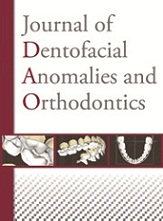Article contents
Evaluation of airway volume changes in patients treated with distraction osteogenesis: a pilot study
Published online by Cambridge University Press: 23 February 2011
Abstract
The use of distraction osteogenesis to improve the airway volume of individuals affected by craniofacial anomalies is common practice today. The methods of assessing the outcomes of such surgical procedures have changed over the last several years.
Objective : The objective of the present pilot study was to determine if the CBCT imaging modality may serve as a simple and reliable method for craniofacial practitioners to evaluate airway volume changes following distraction osteogenesis.
Materials and Methods : Twelve patients who had previously undergone distraction osteogenesis for the primary purpose of improving their airways were enrolled in the current study. Pre (T0) and post-surgical (T1) CBCT’s volumes were analyzed to measure the nasopharyngeal (NP) and oropharyngeal (OP) volume changes. InVivoDental 4.0 (Anatomage Inc., San Jose, CA) (IVD) program was used to visualize and render the oropharyngeal (OP) and nasal passage (NP) volumes, separately. Means and standard deviations were calculated.
Results : Of the 7 males and 5 females in the study, 4 patients underwent mandibular distraction (MandDO) and 8 underwent maxillary distraction (MaxDO). Four in the MaxDO group were treated with internal distractors and 4 were treated with external distractors. Individuals who underwent internal MaxDO greatly improved their NP volumes (1605 ± 1736 to 3273 ± 3130 mm3) as did patients who underwent external MaxDO (5763 ± 5077 to 9243 ± 9442 mm3). In comparison, the MandDO group’s NP volume showed modest gains (3519 ± 1944 to 3894 ± 2516 mm3). With regard to the OP volumes, the MandDO group gained substantially (4906 ± 2347 to 11385.8 ± 6393.5 mm3) while the MaxDO groups showed humble increases; internal MaxDO group (1779 ± 273.8 to 2639.5 ± 898.4 mm3) and the external MaxDO group (8959 ± 5311 to 9734.13 ± 7124.7 mm3).
Conclusions : In the present preliminary study of assessing airway volume changes using CBCT on patients who have undergone different DO techniques, MandDO greatly increases OP volumes and MaxDO tends to increase NP volumes. The CBCT imaging modality holds great promise for craniofacial practitioners in its application to assess airways of individuals affected by craniofacial anomalies.
- Type
- Research Article
- Information
- Journal of Dentofacial Anomalies and Orthodontics , Volume 13 , Issue 3: Hyperdivergence , September 2010 , pp. 223 - 234
- Copyright
- © RODF / EDP Sciences
- 1
- Cited by




